Snow Goose
- February 20, 2024
- 0 comment
The Snow Goose, also known by its scientific name Anser caerulescens, is a captivating member of the waterfowl family renowned for its stunning white plumage. These majestic birds are native to North America and are often spotted in their characteristic V-shaped formations during their annual migrations. Snow Geese are divided into two main types: the Lesser Snow Goose and the Ross’s Goose. Lesser Snow Geese are larger and sport a distinctive black “grin patch” along their bills, while Ross’s Geese are smaller with a stubbier bill and lack the grin patch.

These birds primarily inhabit Arctic tundra during the breeding season, forming large nesting colonies near freshwater lakes and ponds. In winter, they migrate to various regions of North America, including coastal marshes, wetlands, and agricultural fields. Snow Geese are primarily herbivorous, feeding on a variety of plant matter such as grasses, sedges, and agricultural crops. They are known for their voracious feeding habits, often foraging in large flocks and causing significant damage to crops. Snow Geese play a vital role in ecosystem dynamics, influencing vegetation growth and providing food for predators. They also hold cultural significance for many Indigenous peoples, symbolizing abundance, fertility, and connection to the land.
Observing Snow Geese in their natural habitats is a popular pastime for birdwatchers, with numerous wildlife refuges, national parks, and birdwatching hotspots offering opportunities for sightings. Overall, Snow Geese are enchanting creatures that captivate with their beauty, grace, and importance in ecosystems.
| Specification | Description |
|---|---|
| Scientific Name | Anser caerulescens |
| Common Name | Snow Goose |
| Types | Lesser Snow Goose, Ross’s Goose |
| Plumage | Predominantly white with black wingtips |
| Size | Wingspan: 50-67 inches; Weight: 3-7 pounds |
| Habitat | Arctic tundra during breeding; Various regions of North America during winter |
| Diet | Herbivorous; Feeds on grasses, sedges, agricultural crops |
| Behavior | Forms large nesting colonies; Migrates in V-shaped formations |
| Cultural Significance | Symbolizes abundance, fertility, and connection to the land |
| Conservation Status | Not endangered; Conservation efforts ongoing |
| Predators | Arctic foxes, wolves, polar bears, predatory birds |
| Lifespan | Up to 15 years in the wild |
| Migration | Long-distance migrations between breeding and wintering grounds |
| Economic Importance | Contributes to local economies through hunting and tourism |
| Key Habitats | Coastal marshes, wetlands, agricultural fields |
A Majestic Wanderer of the Skies
The Snow Goose, an elegant and charismatic bird of the waterfowl family, is renowned for its striking white plumage and majestic flights across vast landscapes. This article delves into the intriguing world of the Snow Goose, exploring its characteristics, habitat, behavior, and significance.
Introduction to Snow Goose
What is a Snow Goose?
The Snow Goose, scientifically known as Anser caerulescens, is a species of waterfowl native to North America. It is renowned for its striking white plumage, which is accented by black wingtips visible during flight. Snow Geese are medium to large-sized birds with a wingspan ranging from 50 to 67 inches and a weight typically between 3 to 7 pounds. Males are usually larger than females.

Brief overview of its characteristics and habitat
Snow Geese are characterized by their white plumage, though some individuals may exhibit grayish coloring. They have a wingspan ranging from 50 to 67 inches and weigh between 3 to 7 pounds, with males typically larger than females. These birds primarily inhabit Arctic tundra during the breeding season and migrate to various regions of North America during winter.
Physical Characteristics
Plumage variations
Snow Geese exhibit variations in plumage, with adults typically sporting predominantly white feathers tinged with gray. Some individuals may have a completely white plumage, while others may display a more mottled appearance with varying shades of gray. Juveniles often have a more subdued coloring compared to adults, with less distinct markings.
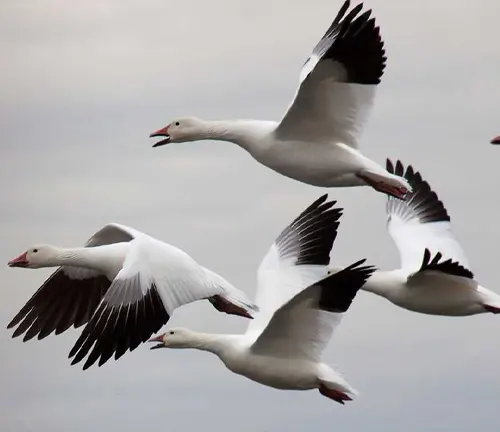
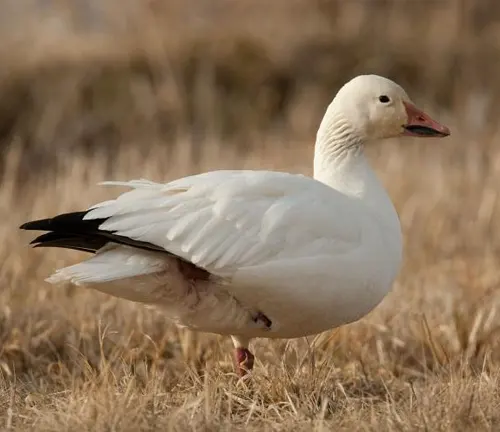
Size and weight
Snow Geese are medium to large-sized birds with a wingspan ranging from 50 to 67 inches (127 to 170 cm). They typically weigh between 3 to 7 pounds (1.4 to 3.2 kg), with males generally larger and heavier than females. However, there can be variations in size and weight within populations due to factors such as age and nutritional status. Overall, Snow Geese possess an impressive physical stature that contributes to their majestic presence in their natural habitats.
Habitat and Migration
Preferred habitats
During the breeding season, Snow Geese prefer to inhabit Arctic tundra regions. They typically nest in colonies near freshwater lakes and ponds, where they can find ample food resources and suitable nesting sites. These habitats provide the necessary conditions for breeding, including access to water for drinking and bathing, as well as abundant vegetation for feeding and shelter. In winter, Snow Geese migrate to various regions of North America, including coastal marshes, wetlands, and agricultural fields. They may also frequent urban parks and golf courses where suitable foraging opportunities exist.
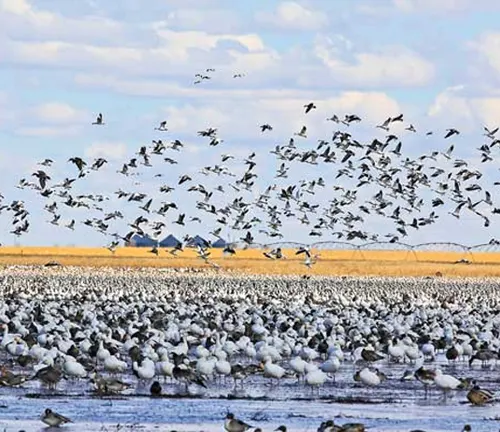
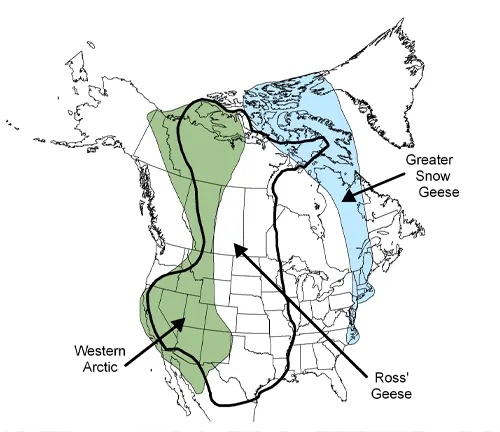
Migration patterns and routes
Snow Geese undertake long-distance migrations between their breeding and wintering grounds. Their migration patterns are influenced by seasonal changes in temperature, daylight, and food availability. During migration, Snow Geese form large flocks and follow established routes that often span thousands of miles. They utilize key stopover sites along the way to rest and refuel, making strategic stops to feed and replenish their energy reserves. Common migration routes include the Central and Mississippi Flyways in North America, where Snow Geese can be observed in large numbers during their seasonal migrations. Overall, the migration of Snow Geese is a remarkable phenomenon that showcases their adaptability and endurance in traversing vast distances across the continent.
Diet and Feeding Behavior
Primary food sources
Snow Geese are primarily herbivorous birds, with their diet consisting mainly of plant matter. They feed on a variety of vegetation, including grasses, sedges, and agricultural crops. During the breeding season in Arctic tundra regions, they may also consume plant roots and tubers found in the marshy areas near their nesting sites. In winter, Snow Geese forage in agricultural fields, where they feed on grains such as wheat, barley, and corn, as well as leftover crop residues. They are opportunistic feeders and will exploit whatever food resources are available in their environment.
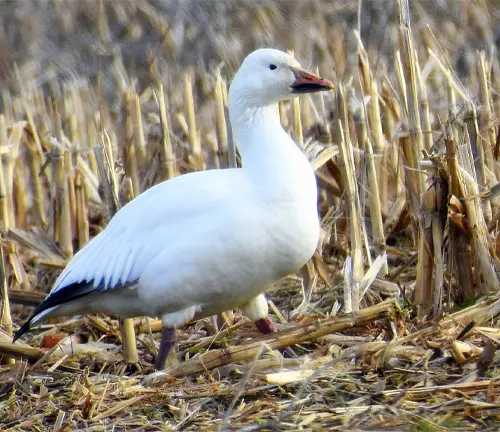
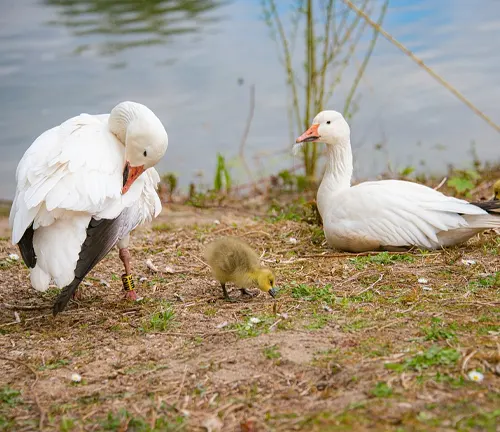
Feeding habits
Snow Geese are known for their voracious feeding habits, often foraging in large flocks, especially during the winter months when they congregate in agricultural areas. They use their powerful bills to uproot plants and graze on vegetation close to the ground. Snow Geese are capable of causing significant damage to crops, particularly when feeding in large numbers, which can sometimes lead to conflicts with farmers. Their feeding behavior is highly synchronized, with individuals in a flock coordinating their movements to efficiently exploit food resources. Despite their herbivorous diet, Snow Geese play an important role in ecosystem dynamics by influencing vegetation growth and nutrient cycling in their habitats.
Reproduction and Nesting
Breeding season
Snow Geese breed during the summer months, typically from May to August, depending on their location and environmental conditions. Breeding occurs in Arctic tundra regions, where temperatures are conducive to nesting and raising offspring. The onset of breeding is triggered by increasing daylight hours and the availability of suitable nesting sites and food resources. During this time, Snow Geese form large nesting colonies, or rookeries, consisting of hundreds to thousands of breeding pairs.
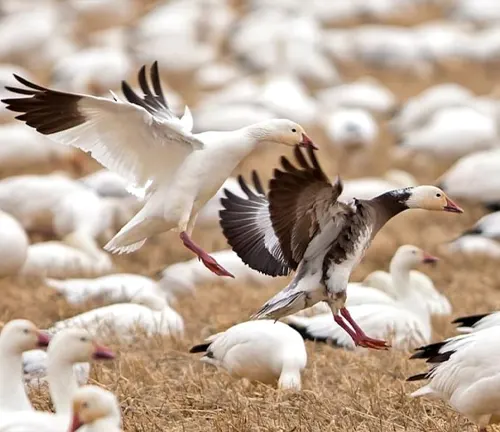

Nesting habits and locations
Snow Geese construct their nests on the ground using plant material such as grasses, sedges, and moss. The nests are often lined with down feathers for insulation and warmth. They prefer nesting sites near freshwater lakes and ponds, as well as in marshy areas with dense vegetation that provides cover and protection from predators. Nesting colonies can be found in various locations within Arctic tundra regions, including coastal areas, river deltas, and inland wetlands. Snow Geese exhibit strong site fidelity, often returning to the same nesting sites year after year. The proximity to water is essential for easy access to food and the safety of their offspring. Once the breeding season is over, Snow Geese begin their long migration southward to wintering grounds in warmer climates.
Predators and Threats
Natural predators
Snow Geese face predation from various natural predators throughout their range. In their Arctic breeding grounds, predators such as Arctic foxes (Vulpes lagopus), Arctic wolves (Canis lupus arctos), and polar bears (Ursus maritimus) may prey on eggs, nestlings, or vulnerable adult birds. These predators are well-adapted to the harsh Arctic environment and are skilled hunters capable of ambushing unwary prey.
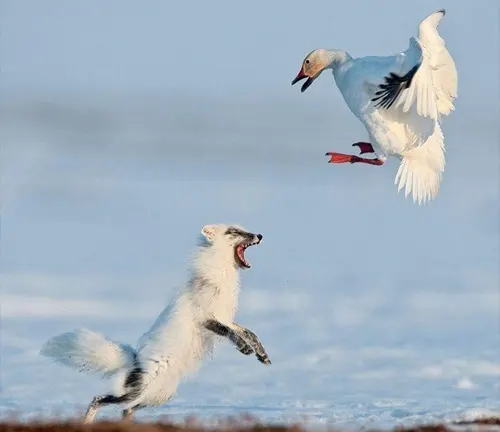
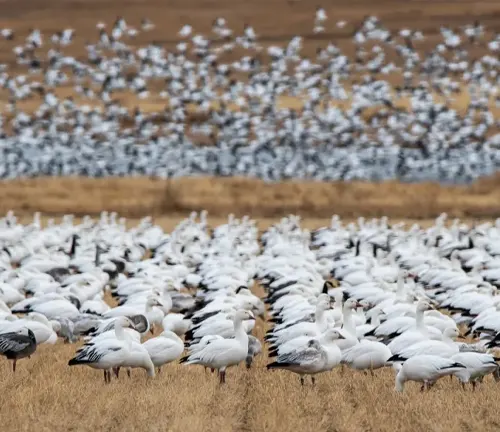
Human-induced threats
In addition to natural predators, Snow Geese also face threats from human activities, which can have significant impacts on their populations and habitats. Habitat loss and degradation due to urbanization, industrial development, and agriculture pose significant threats to Snow Geese breeding and wintering grounds. Wetland drainage, conversion of natural habitats into agricultural fields, and pollution from agricultural runoff can all negatively impact the availability of suitable nesting and foraging sites for Snow Geese.
Conservation Efforts
Initiatives to Protect Snow Geese Populations
Numerous initiatives have been implemented to protect Snow Geese populations and their habitats, aiming to mitigate the threats they face from human activities and environmental changes. These initiatives include:
- Habitat Conservation: Efforts to preserve and restore wetlands, coastal marshes, and other critical habitats for Snow Geese breeding, migration, and wintering are essential for maintaining viable populations. Conservation measures may include land acquisition, habitat restoration, and the establishment of protected areas.
- Monitoring and Research: Comprehensive monitoring programs and scientific research initiatives help assess the status of Snow Geese populations, understand their ecology and behavior, and identify conservation priorities. These efforts provide valuable data for informing management decisions and implementing effective conservation strategies.
- Hunting Regulations: Sustainable hunting regulations and man
agement practices are crucial for ensuring the long-term viability of Snow Geese populations while allowing for recreational hunting opportunities. Regulations may include bag limits, hunting seasons, and restrictions on hunting methods to prevent overexploitation of populations. - Public Education and Outreach: Educational programs, outreach activities, and public awareness campaigns raise awareness about the importance of Snow Geese conservation and promote stewardship of their habitats. Engaging with local communities, landowners, and stakeholders fosters support for conservation initiatives and encourages responsible land management practices.
Conservation Organizations Involved
Several conservation organizations are actively involved in efforts to protect Snow Geese populations and their habitats. These organizations include:
- Ducks Unlimited: Ducks Unlimited is a leading conservation organization dedicated to the conservation of wetlands and waterfowl habitats across North America. Through habitat conservation projects, research, and advocacy, Ducks Unlimited works to ensure the long-term sustainability of Snow Geese and other waterfowl species.
- National Audubon Society: The National Audubon Society is a nonprofit organization focused on bird conservation and habitat protection. Audubon’s network of chapters and conservation programs supports initiatives to conserve Snow Geese and their habitats through research, education, and advocacy.
- U.S. Fish and Wildlife Service (USFWS): The USFWS is a federal agency responsible for the management and conservation of wildlife and their habitats in the United States. The agency implements conservation programs, enforces hunting regulations, and collaborates with partners to protect Snow Geese populations and their habitats.
- Canadian Wildlife Service (CWS): The Canadian Wildlife Service is a government agency responsible for wildlife conservation and management in Canada. CWS conducts research, monitors populations, and implements conservation programs to protect Snow Geese and other migratory birds across their range in Canada.
Different Species
Greater Snow Goose
(Anser caerulescens atlanticus)
The Greater Snow Goose is one of the two recognized subspecies of Snow Goose. It breeds in the Arctic regions of Canada, particularly in the eastern Canadian Arctic and Greenland. Greater Snow Geese have a larger body size compared to Lesser Snow Geese and exhibit variations in plumage, with some individuals having a darker coloration. They migrate along the Atlantic Flyway to wintering grounds along the Atlantic coast of the United States and as far south as North Carolina.
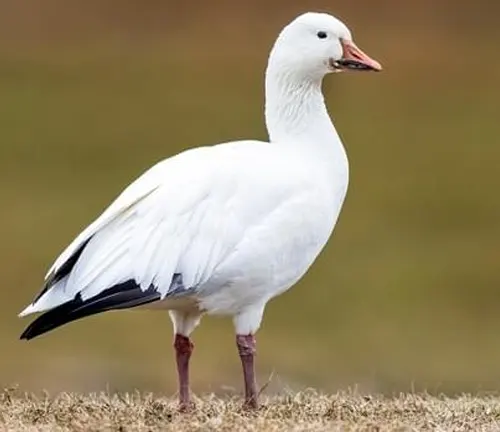
Lesser Snow Goose
(Anser caerulescens caerulescens)
The Lesser Snow Goose is the other subspecies of Snow Goose. It breeds in the Arctic regions of North America, including the Canadian Arctic and western Greenland. Lesser Snow Geese are smaller in size compared to Greater Snow Geese and typically have a lighter coloration, with predominantly white plumage. They migrate along the Central and Pacific Flyways to wintering grounds in the southern United States, Mexico, and occasionally as far south as Central America.
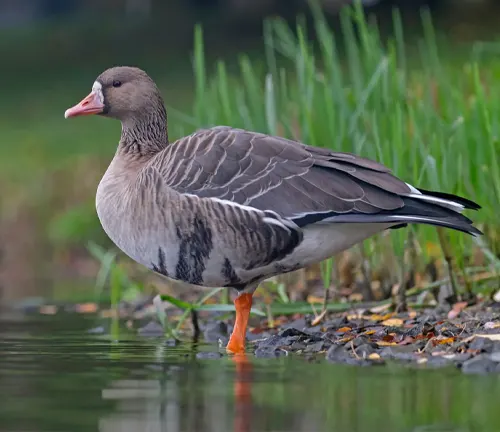
Frequently Asked Questions (FAQs)
- Do Snow Geese mate for life?
Yes, Snow Geese typically form lifelong pair bonds with their mates. - Are Snow Geese endangered?
Snow Geese are not currently endangered, but conservation efforts are in place to manage their populations sustainably. - What do Snow Geese eat?
Snow Geese primarily feed on plant matter such as grasses, sedges, and agricultural crops. - Where can I see Snow Geese?
Snow Geese can be observed in their natural habitats at wildlife refuges, national parks, and birdwatching hotspots across North America. - How far do Snow Geese migrate?
Snow Geese undertake long-distance migrations, traveling thousands of miles between their breeding and wintering grounds. - Do Snow Geese travel in flocks?
Yes, Snow Geese are highly social birds and often travel in large flocks, especially during migration. - What is the purpose of Snow Geese migration?
Migration allows Snow Geese to access different food sources and breeding grounds, as well as escape harsh weather conditions. - How many eggs do Snow Geese lay?
Snow Geese typically lay 3 to 6 eggs per clutch, with nesting pairs sharing incubation duties. - Do Snow Geese have any predators?
Yes, Snow Geese face predation from various natural predators such as Arctic foxes, polar bears, and predatory birds. - Why are Snow Geese called “Snow” Geese?
Snow Geese are named for their predominantly white plumage, which resembles the color of snow. - Do Snow Geese make any sounds?
Yes, Snow Geese are known for their distinctive honking calls, especially during migration and while in flight. - Are Snow Geese monogamous?
Yes, Snow Geese typically form monogamous pair bonds and mate with the same partner year after year. - How long do Snow Geese live?
Snow Geese can live up to 15 years in the wild, although their lifespan can vary depending on factors such as predation and habitat quality.


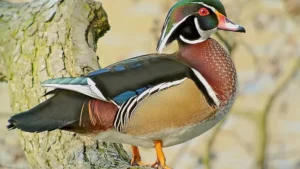
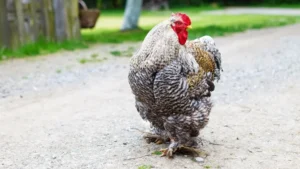
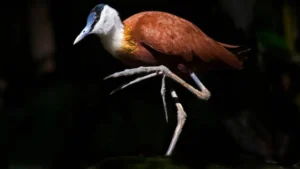

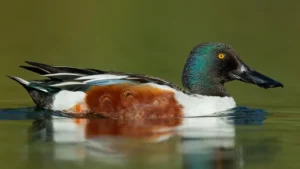

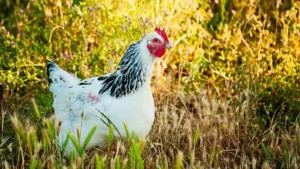


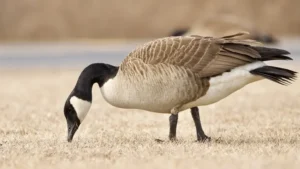

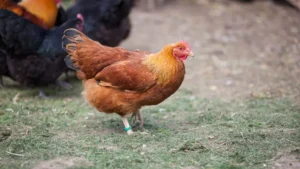
Leave your comment